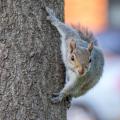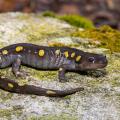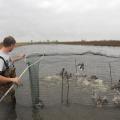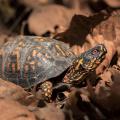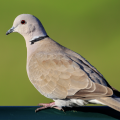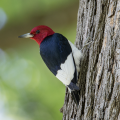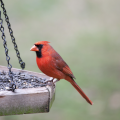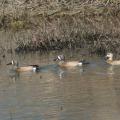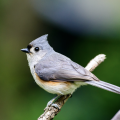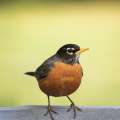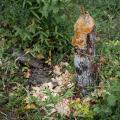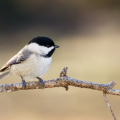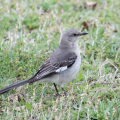News Filed Under Wildlife
Have you ever been on a walk in the woods, park, or backyard and noticed animal tracks in the mud or dirt? Some tracks are easy to identify, while others are a bit harder to tell which animal they belong to. It’s a fun guessing game trying to figure out which animal has been visiting nearby.
When examining animal tracks, ask yourself a few questions:
The yellow-spotted salamander is a slippery, shiny Mississippi amphibian. Also known as Ambystoma maculatum, this is a large amphibian, measuring between six to nine inches!
Have you ever been on a walk in the woods, park, or backyard and noticed animal tracks in the mud or dirt? Some tracks are easy to identify, while others are a bit harder to tell which animal they belong to.
RAYMOND, Miss. -- A large group of agricultural producers and industry professionals met with Mississippi State University personnel during the 2025 Central Mississippi Producer Advisory Council meeting Feb. 18 in Raymond at the Central Mississippi Research and Extension Center. The annual forum provides clients, MSU administrators, researchers, specialists and Extension agents an opportunity to meet in small commodity groups to discuss the research and educational needs of producers in the region.
Landowners working to improve game bird habitat can sign up for Feb. 28 and March 1 weekend events that provide practical information for property management.
The Mississippi State University Extension Service is hosting the turkey and quail management social and workshop in Shannon, Mississippi.
STARKVILLE, Miss. -- A Mississippi State University Extension professor has been recognized for his contributions to wildlife conservation with the Clarence W. Watson Award.
STARKVILLE, Miss. -- Hunters and birders in Mississippi who spot ducks wearing backpacks in the next five years do not need to get their eyes checked.
A new Mississippi State University Extension Service waterfowl study aims to arm landowners with practical habitat management recommendations that will support mallard populations in the Southeast. MSU Extension is teaming with the Mississippi Department of Wildlife, Fisheries and Parks, or MDWFP, to track the movements and migration patterns of female mallards for the research.
RAYMOND, Miss. -- Frustration is mounting for deer hunters across Mississippi whose cool-season food plots died or never got planted because of drought conditions. Although it’s November, hunters still have time to replant.
RAYMOND, Miss. -- Small ruminants are a popular choice for people like J.T. Crownover who want to get into the livestock business but do not want to raise cattle. Crownover attended the Central Mississippi Research and Extension Center’s Producer Advisory Council meeting Feb. 20. The forum, where agricultural producers can discuss their needs with MSU administrators, researchers, specialists and Extension agents, was the catalyst for the university’s active small ruminant program.
STARKVILLE, Miss. -- “Where are all the ducks?” It’s a question James Callicutt fields with more frequency and urgency from hunters and birders in Mississippi by the year.
Callicutt, a Mississippi State University Extension Service instructor specializing in waterfowl and wetlands ecology, said aerial waterfowl survey data show duck abundance in the southeastern U.S. is well below average.
We’ve reached the end of our yearlong series that introduced you to some of Mississippi’s birds! We hope these blog posts have helped you identify and learn more about our feathered friends.
Many birds aren’t as easy to identify as red-headed woodpeckers. With their bright red head and neck feathers and loud pecking noise, they surely know how to make their presence known!
Want your feathered friends to have a supplemental source of food this winter? Set out a bird feeder for them. There are many types of bird feeders, but they are not all created equal. Check out the common types of feeders and decide which ones will work best in your yard.
September tends to mark the end of summer, and our thoughts drift toward cooler weather activities such as fall gardening, football and hunting.
In the world of birds, fall marks the time for many to begin their migration. Most species of birds migrate to some extent, but as renowned waterfowl biologist Frank Bellrose said, “Waterfowl are highly visible in migration; they epitomize this phenomenon for most people.”
The tufted titmouse is a bird you’ve likely seen in parks, woodlands, and in your back yard. They’re native to the eastern parts of the United States and are attracted to areas where there is an abundance of broadleaf trees, such as oaks, hickories, and maples.
“Rockin’ robin, tweet-tweedle-lee-dee!” You sang that sentence as you read it, didn’t you?
Shortly after Emily Duggar bought property in Madison County to build a house near Canton, she realized there were beavers on a creek that ran through the back of the property.
“We saw evidence that beavers were taking down trees and gnawing on trees,” Duggar said. “We could see they were building a dam, and they’ve since built two more dams. The water is rising,” she said. “We haven’t had any flooding yet, but we’ve heard that some people who live in the neighborhoods behind our property have flooding from the creek.”
If you hear a bird call that sounds like a fast, high pitched “chick-a-dee-dee-dee,” you can confidently say it’s coming from a Carolina chickadee– they get their name from this distinctive call.
Every Mississippian is familiar with the northern mockingbird. In 1944, it became the official bird of Mississippi.

